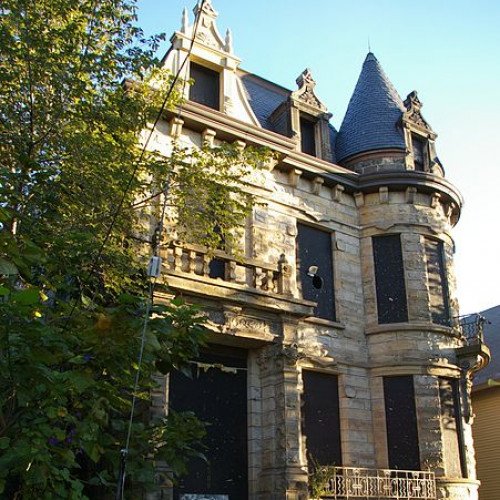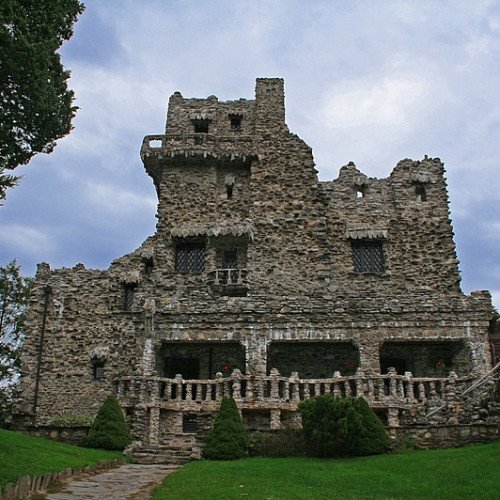Castles of "United States" FRANKLIN CASTLE vs GILLETTE CASTLE STATE PARK

FRANKLIN CASTLE
Franklin Castle (also known as the Tiedemann House) is a Victorian stone house, built in the American Queen Anne style, located at 4308 Franklin Boulevard in Cleveland's Ohio City neighborhood. The building has four stories and more than twenty rooms and eighty windows. In the late nineteenth century, when it was built, Franklin Boulevard was one of the most prestigious residential avenues in Cleveland. It is reported to be the most haunted house in Ohio. On March 15, 1982, it was added to the National Register of Historic Places. The house was built in 1881-1883 by the famed architectural firm of Cudell & Richardson for Hannes Tiedemann, a prosperous German immigrant. On January 15, 1881, Tiedemann's fifteen-year-old daughter Emma succumbed to diabetes. The property saw its second death not long afterwards when Tiedemann's elderly mother, Wiebeka, died. During the next three years the Tiedemanns would bury three more children, giving rise to speculation that there was more to the deaths than met the eye. To distract his wife, Louise, from these tragedies, Tiedemann began extensive construction on the home, adding a ballroom which runs the length of the house on the fourth floor of the manor. Also during this building, turrets and gargoyles were added to the edifice's facade, giving the house an even more pronounced "castle" appearance. It is rumored that hidden rooms and passageways were used for bootlegging during Prohibition. Though rumored, none of these rooms or passageways exist other than a small stairway used by servants from the kitchen to the front door.
Statistics for this Xoptio

GILLETTE CASTLE STATE PARK
Gillette Castle State Park straddles the towns of East Haddam and Lyme, Connecticut in the United States, sitting high above the Connecticut River. The castle was originally a private residence commissioned and designed by William Gillette, an American actor who is most famous for his portrayal of Sherlock Holmes on stage. Gillette lived at this estate from 1919–1937. The estate was purchased by the state of Connecticut in 1943 for a price of $5,000. William Gillette's "castle", called Seventh Sister and renamed "Gillette Castle" by Connecticut State in 1943, was built between 1914 and 1919 with an addition completed in 1924 on a 184-acre (74 ha) tract at the top of the southernmost of a chain of hills known as the Seven Sisters. Gillette died having no children, and his will precluded the possession of his home by any "blithering sap-head who has no conception of where he is or with what surrounded". The State of Connecticut took over the property in 1943, renaming it Gillette Castle State Park. It was added to the National Register of Historic Places in 1986. Gillette originally planned to build his retirement home on Long Island until he discovered the cliffs of the Seven Sisters while traversing the Connecticut River in his houseboat, "Aunt Polly". Gillette designed the home and personally overlooked every phase of the construction. Construction was performed by the Porteus-Walker Company, a leading contracting and wood-working firm based in Hartford, Connecticut founded by Gillette's childhood friend, Robert Porteus. It has been described as being designed in a medieval gothic, or an "American fairy tale mixed with European flair" style, or as "a weird blending of Victorian and Arts and Crafts". In the past, it had even been described as "Gillette's Folly".